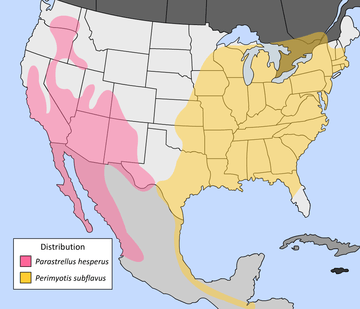Tricolored bat
| Tricolored bat | |
|---|---|
| | |
| Scientific classification | |
| Kingdom: | Animalia |
| Phylum: | Chordata |
| Class: | Mammalia |
| Order: | Chiroptera |
| Family: | Vespertilionidae |
| Genus: | Perimyotis Menu, 1984 |
| Species: | P. subflavus |
| Binomial name | |
| Perimyotis subflavus F. Cuvier, 1832 | |
| Synonyms | |
|
Pipistrellus subflavus | |
Formerly known as the eastern pipistrelle, technically an inaccurate classification,[2] the new more descriptive common name tricolored bat (Perimyotis subflavus) was chosen because of the distinct tricoloration of each hair, which is black at the base, yellow in the middle and brown at the tips. This species of bat is widely distributed throughout the eastern parts of America and Canada, ranging west until Kansas, Oklahoma, and Texas, from Honduras up north until southern Ontario. It is the only member of the genus Perimyotis.
Description
This reddish, yellowish and brownish bat is one of the smallest bats in eastern North America. The forearms are orange to red, and the wing membrane is black. Adults weigh between 4 and 10 g and reach a forearm length of 30 to 35 mm. They are easily distinguished from other similar species by their tricolored fur. These bats were renamed by Dr. Paul Cryan with the US Geological Survey.
Life history
Tricolored bats mate in autumn in the area around their hibernacula. The females store their mates' sperm inside their reproductive tracts during their hibernation in winter and ovulate in early spring. They hibernate alone or in small groups in caves or mines at temperatures from 4 to 10 °C, and they usually return to the same hibernation site year after year. When they wake up from hibernation, the females form maternity colonies that are no bigger than 20 bats, whereas the males roost alone during summer. These maternity colonies roost in foliage and are usually exposed to more light than any other bat species. After a gestation period of 44 to 60 days, one to two pups are born in June. (Most other species of bats give birth to only one offspring.) Each one weighs about 20% of its mother's weight. For the first few days after birth the mother carries the blind and hairless pups between roosts. They grow quickly, are able to fly within 14–21 days and stop getting nursed at four weeks of age.
Male tricolored bats live for about 15 years; the females can get as old as 10 years.
Feeding
These bats eat small insects. They hunt at the edges of forests, near streams or over open water and can achieve a speed of about 18 km/h. When the pipistrelles capture food they use the tail or wing membranes to restrain their prey. Some insects are even captured by their tail membrane. It forms a pouch and the bat bends its head in to grab the insect with its teeth. They can catch insects as much as every 2 seconds and increase their mass by 25% in only half an hour.
Threats
White-nose syndrome (WNS) is a devastating disease responsible for mass mortalities in hibernating North American cave bats. There has never been another known significant disease outbreak affecting any bat species in North America. By the end of 2011, this rapidly spreading threat had killed 5.7 to 6.7 million bats in the eastern United States since the discovery of the first infected bats in 2006, in New York. The causative agent of white-nose syndrome, a cold-adapted fungal species, Pseudogymnoascus destructans, is now in 30 states and 5 Canadian provinces. Fungal hyphae penetrate the epidermis and connective tissues causing the cutaneous infection associated with WNS. White-nose syndrome causes white mycelial growth of the fungus, often on the muzzles, ears, or wings of infected bats (any surface without fur). The fungus grows while bats are hibernating, and therefore immuno-compromised.
Classification
Although traditionally considered a member of the genus Pipistrellus, a growing body of evidence suggests that the Eastern Pipistrelle is only distantly related to the pipistrelles proper. Hoofer and Van Den Bussche found the Pipistrellini (containing Pipistrellus s.s., Nyctalus, and Scotoecus) sister to the Vespertillionini.[3] Both the Eastern and Western Pipistrelle were outside of this clade. They suggest that the Eastern Pipistrelle be removed from the genus Pipistrellus and placed in its own genus, Perimyotis.

See also
References
- ↑ Arroyo-Cabrales, J.; Miller, B.; Reid, F.; Cuarón, A.D. & de Grammont, P.C. (2008). "Pipistrellus subflavus". IUCN Red List of Threatened Species. Version 2009.2. International Union for Conservation of Nature. Retrieved 7 February 2010.
- ↑ http://scienceblogs.com/tetrapodzoology/2011/04/12/placing-perimyotines/
- ↑ Hoofer, Steven R; Ronald A Van den Bussche (2003). "Molecular phylogenetics of the chiropteran family Vespertillionidae". Acta Chiropterologica. 5 (supplement): 1–63. doi:10.3161/001.005.s101.
- ↑ Dalquest, Walter Woelber; Eugene Raymond Hall (1950-01-20). A Synopsis of the American Bats of the Genus Pipistrellus by Dalquest and Hall. 1. Lawrence, Kansas: University of Kansas. pp. 591–602.
External links
- The Eastern Pipistrelle from Texas Parks & Wildlife.
- Pipistrellus subflavus at ADW.
